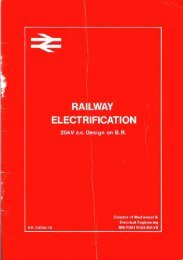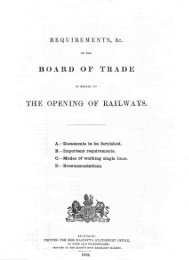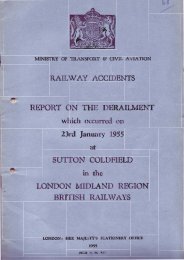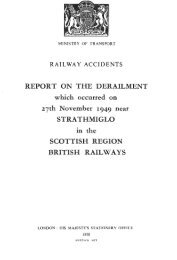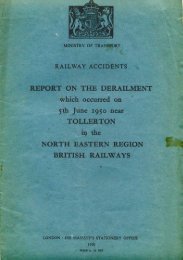R A I LT R AC K - The Railways Archive
R A I LT R AC K - The Railways Archive
R A I LT R AC K - The Railways Archive
You also want an ePaper? Increase the reach of your titles
YUMPU automatically turns print PDFs into web optimized ePapers that Google loves.
Route characteristics<br />
DESCRIPTION This route carries both passenger and freight trains between<br />
London, the Channel Tunnel and beyond, as well as domestic services to South<br />
East London and Kent.<br />
From Victoria to Swanley this route is four track (two tracks via Herne Hill<br />
and two via the Catford Loop) with a predominant linespeed of 60mph.<br />
From Charing Cross and Cannon Street to Orpington, this is a four-track<br />
line with a 60mph linespeed rising to 70mph beyond Hither Green. Beyond<br />
Orpington, the route is primarily two track, with linespeed varying between<br />
80mph and 100mph.<br />
<strong>The</strong> route also includes Swanley–Ashford via Maidstone East, a two-track<br />
line with speeds between 70mph and 80mph. All lines are electrified.<br />
BOTTLENECK ANALYSIS <strong>The</strong>re are a number of capacity constraints<br />
between Charing Cross and Orpington, the most severe of which is the twotrack<br />
section between Borough Market Junction and Metropolitan Junction. In the<br />
area between Charing Cross and London Bridge, which includes this short<br />
section, there are a number of flat junctions and the tracks converge and diverge<br />
leaving either two or four tracks. <strong>The</strong>re are, thus, numerous possible conflicting<br />
moves which restrict available capacity.<br />
Demand for train paths curr e n t ly exceeds the av a i l a ble capacity and, duri n g<br />
the peak, PIXC levels are exceeded and not all trains are able to stop at London<br />
B ridge Station. In addition, the current timetable for this section of route depends<br />
on services running on restricted signalling aspects during the peak hours .<br />
<strong>The</strong> other main constraint is the four-track section between New Cross<br />
Station and Tanners Hill Junction.<br />
Route vision<br />
Our vision for this route is to create new capacity by constructing a 12-vehicle per<br />
t rain suburban netwo rk by 2002 and to capitalise on the new capacity offered by<br />
c o n s t ruction of the CTRL to improve journey times between London and Kent.<br />
We intend to develop the London commuting markets with new journey<br />
opportunities and practical capacity enhancements. Central to this is the<br />
Thameslink 2000 project, due for completion in 2006, which will address the<br />
remaining major bottlenecks.<br />
We are working with the Franchising Director to develop a scheme to<br />
provide additional facilities in the London Bridge area to enable Thameslink 2000<br />
Route development and customer requirements<br />
Wo rking with our customers, we will improve charter punctuality by two<br />
percentage points over the next two ye a rs. This improvement, which will vary<br />
across service groups, will typically result in 16% fe wer trains arriving at their<br />
destinations more than fi ve minutes late.<br />
<strong>The</strong> opening of CTRL Section 1 will also provide a significant increase in<br />
capacity, both to the benefit of Eurostar on the new route, and for other<br />
operators who can make use of capacity released by Eurostar on the existing<br />
route. <strong>The</strong> 2003 timetable will provide the opportunity to optimise use of the<br />
available capacity by all services and enable significant reductions in journey times<br />
such as London–Ashford in 59 minutes.<br />
Under the Thameslink 2000 project, significant new infrastructure will be<br />
provided including the quadrupling of the section of track between Metropolitan<br />
Junction and Borough Market Junction, thereby doubling capacity. <strong>The</strong> Thameslink<br />
2000 project will both provide the means to accommodate underlying demand<br />
and induce new demand through the changed service pattern. In addition,<br />
discussions continue to assess how to meet other customer aspirations for<br />
further enhancements at London Bridge Station.<br />
We are working with the Franchising Director and customers to develop<br />
additional facilities between New Cross, Tanners Hill and London Bridge Station.<br />
This will provide further relief to this bottleneck.<br />
MAJOR STAT I O N S<br />
London Bridg e This is a very busy station whose role is set to grow with the<br />
Jubilee Line development. <strong>The</strong> opening of the Jubilee Line will see the<br />
underground concourse brought into use. SRP work will begin in 1999, and we<br />
will work with Connex and Thameslink to provide automatic ticket gates. CIS<br />
renewal is planned for 1999/2000. <strong>The</strong> Thameslink 2000 project will bring<br />
opportunities for substantial improvement to this station.<br />
London Charing Cross This is an extremely busy London terminal<br />
constrained by its size. We will improve the concourse area to cater for<br />
passenger growth. We are working with Connex to provide automatic ticket<br />
gates to secure industry revenue. <strong>The</strong> major roof reglazing will be completed in<br />
summer this year.<br />
services to operate while retaining the potential for the existing level of service<br />
to West End locations. This will enable additional services to operate in Central<br />
London on this route. Subject to finalisation of the scope of these works, it is<br />
expected that we will submit a supplementary T&WA Order application for the<br />
scheme to the DETR in autumn this year.<br />
<strong>The</strong> Jubilee Line Extension will lead to increased passenger demand for<br />
London Bridge as an interchange point.<br />
In advance of the CTRL Section 1, works on the Waterloo–Fawkham Junction<br />
section of the route will allow Eurostar services leaving CTRL to successfully<br />
integrate with the domestic services. In the meantime, the route will continue to<br />
service the expected growth in international freight traffic.<br />
Route clearance work for Connex’s new fleet of electric trains has begun<br />
and the operating areas of its existing modern fleets will be extended.<br />
We intend to clear two Channel Tunnel to London routes, via Maidstone<br />
and via Redhill to W10 gauge. We will be able to accommodate our freight<br />
customers forecast demand over both the next five and ten years.<br />
177



